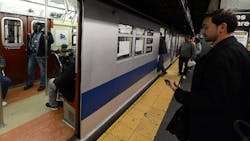Oct. 27, 2020, marks the 116th anniversary of the New York City subway system. The original BMT (Brooklyn Manhattan Rapid Transit – today’s B,D,J,M, N,Q, R and Z lines) and IRT (Interboro Rapid Transit - 1,2,3,4,5,6,7, Franklin Ave and Times Square shuttles) subway systems were constructed and managed by the private sector with no government operating subsidies. Financial viability was 100 percent dependent upon farebox revenues. They supported both development and economic growth of numerous neighborhoods in the boroughs of Manhattan, Brooklyn, Bronx and Queens. As part of the franchise agreement, the owners had to sign and City Hall had direct control over the fare structure. For a period of time, owners actually made a profit with a five-cent fare.
After two decades passed, the costs of salaries, maintenance, power, supplies and equipment would pressure owners to ask City Hall for permission to raise the fares. This additional revenue was needed to maintain a state of good repair, increase the frequency of service, purchase new subway cars, pay employee salary increases and support planned system expansion. Politicians more interested in the next reelection (and subscribing to the old Roman philosophy of free bread and circuses) refused this request each year for well over two decades. As a result, in order to survive, owners of both systems began looking elsewhere to reduce costs and stay in business. They started curtailing basic maintenance, delayed purchases of new subway cars, postponed salary increases for employees, canceled any plans for system expansion and cut corners to survive. (Does any of this sound familiar from the present?)
In the 1930s, NYC began building and financing construction of the new IND (Independent Subway – today’s A,C,E,F and G lines). This new municipal system subsidized by taxpayers dollars would provide direct competition to both the IRT and BMT. Municipal government forced them into economic ruin by denying them fare increases that would have provided access to additional badly needed revenues. Big Brother, just like the Godfather, eventually made them an offer they couldn’t refuse. The owners folded and sold out to City Hall.
In 1953, the old NYC Board of Transportation passed on control of the municipal subway system, including all its assets to the newly created New York City Transit Authority. Under late Gov. Nelson Rockefeller in the 1960s, the Metropolitan Transportation Authority was created. The governor appointed four board members as did the NYC mayor with the remaining board positions appointed by suburban county executives. No single elected official controlled a majority of the votes.
In June 1956, the A line was extended to provide new service to the Rockaways replacing the Long Island Rail Road, which previously abandoned service on the same corridor.
Until the early 1960s, most subway stations had clean, safe, working bathrooms with toilet paper. Revenues generated from a 10-cent fee helped cover the costs. During this time, it was common to find both penny gum and 10-cent soda machines dispensing products at many subway stations. It was a time when people respected authority and law. That generation of riders did not litter subway stations and buses leaving behind gum, candy wrappers, paper cups, bottles and newspapers. No one would openly eat pizza, chicken or other messy foods while riding a bus or subway.
In December 1988, at a cost of $450 million (primarily funded with grants from the Urban Mass Transportation Administration, today known as the Federal Transit Administration), the Archer Avenue subway line was opened. Thanks to this investment, the J/Z and E lines provided direct service to both the Long Island Rail Road Jamaica Station and new terminus at Archer Avenue & Parsons Blvd. in Jamaica, Queens.
In December 2001, at a cost of $650 million (primarily funded with grants from Washington), the 63rd Street Tunnel between Queens and Manhattan was opened. Thanks to this investment, the Queens Blvd. F line continues to provide direct service to the 6th Avenue corridor in Manhattan without having to use the old 53rd Street tunnel between Queens and Manhattan. This affords riders additional service options for those traveling from Queens to Manhattan.
In September 2015, at a cost of $2.4 billion, thanks to this investment funded by the city of New York, the Flushing 7 subway extension from Times Square to the new Hudson Yards Station adjacent to the Javits Convention Center opened for service.
On Jan. 1, 2017, at a cost of $4.5 billion (funded by an FTA New Starts Full Funding Grant Agreement), the first Phase of Second Avenue subway was up and running from 63rd to 96th Street on the Manhattan east side.
In 1996, Metro Cards were introduced. This provides free transfers between the subway and bus. It eliminated the old two fare zones, making public transportation an even better bargain. Purchasing a weekly or monthly subway/bus pass reduces the cost per ride and provides virtually unlimited trips. In many cases, employers can offer transit checks to help subsidizes a portion of the cost. Utilize this and reap the benefits. It supports a cleaner environment. MTA NYC Transit is in the process of introducing the next generation of fare collection. It is known as One Metro New York (OMNY). Installation of this new state of the art system should be completed and available to all riders in 2021.
Today, thanks to former NYC Transit President Andy Byford, the MTA NYC Transit’s ongoing FASTRACK initiative is using an entirely new way to perform subway maintenance in the system. By completely suspending train service over a segment of a subway line, workers have uninterrupted access to tracks, signals, cables, lighting, third rail components and platform edges.
Many FASTRACK line shutdowns previously completed resulted in an unprecedented amount of work being accomplished. Most importantly, FASTRACK resulted in a safer and more efficient environment for employees to inspect, maintain and clean the pre COVID-19 24/7 subway system. There is a temporary ongoing shutdown of the system between 1:00 to 5:00 a.m. for COVID-19 cleaning. It is anticipated that 24/7 service will resume sometime in the future.
Transit employees inspected hundreds of signals and switches, repaired and replaced track rails and cross ties, cleaned track floors, performed elevator and escalator repair work, repaired water damage, cleared drains, cleaned stations and repainted areas that had not been touched in years because they are not reachable during normal train operation. They cleaned light fixtures, changed bulbs and repaired platform edges. Employees also performed high intensity station cleaning. These maintenance activities improve train performance and efficiency, while also providing a visible improvement to the station environment.
NYC Transit has a fleet of 6,500 subway cars with 471 stations serving 5.5 million pre COVID-19 riders. Service is provided on 28 routes spanning four of five boroughs comprising NYC including Brooklyn, Bronx, Manhattan and Queens. Only the 500,000 residents of Staten Island have no direct subway connection to the rest of NYC.
The largest subway system in the world has benefited by billions in grant funding provided by the Federal Transit Administration. Of the $1.4 billion in annual FTA funding provided to the MTA, NYC Transit usually receives a minimum of 70 percent or more than $1 billion. These dollars pay for various capital improvement projects which benefit riders. Since the Urban Mass Transportation Act was signed into law by President Lyndon Johnson in 1964, NYC Transit has received billions and billions of dollars in federal assistance from Washington. This is a great example of your tax dollars at work.
Let us also give thanks to the thousands of hard working men and women who maintain and operate the NYC subway system. It is the life line that keeps the Big Apple moving day in and day out.
----------------------------------------------------------
Larry Penner is a transportation advocate, historian and writer who previously worked for the Federal Transit Administration Region 2 New York Office. This included the development, review, approval and oversight for billions in capital projects and programs for the MTA, NYC Transit, Long Island Rail Road, Metro-North Railroad, MTA Bus, NYC DOT, NJ Transit, along with 30 other transit agencies in New York and New Jersey.
About the Author

Larry Penner
Larry Penner is a transportation advocate, historian and writer who previously served as a former director for the Federal Transit Administration Region 2 New York Office of Operations and Program Management. This included the development, review, approval and oversight for billions in capital projects and programs for New Jersey Transit, New York Metropolitan Transportation Authority, NYC Transit bus, subway and Staten Island Railway, Long Island and Metro North railroads, MTA Bus, NYCDOT Staten Island Ferry along with 30 other transit agencies in New York and New Jersey.
